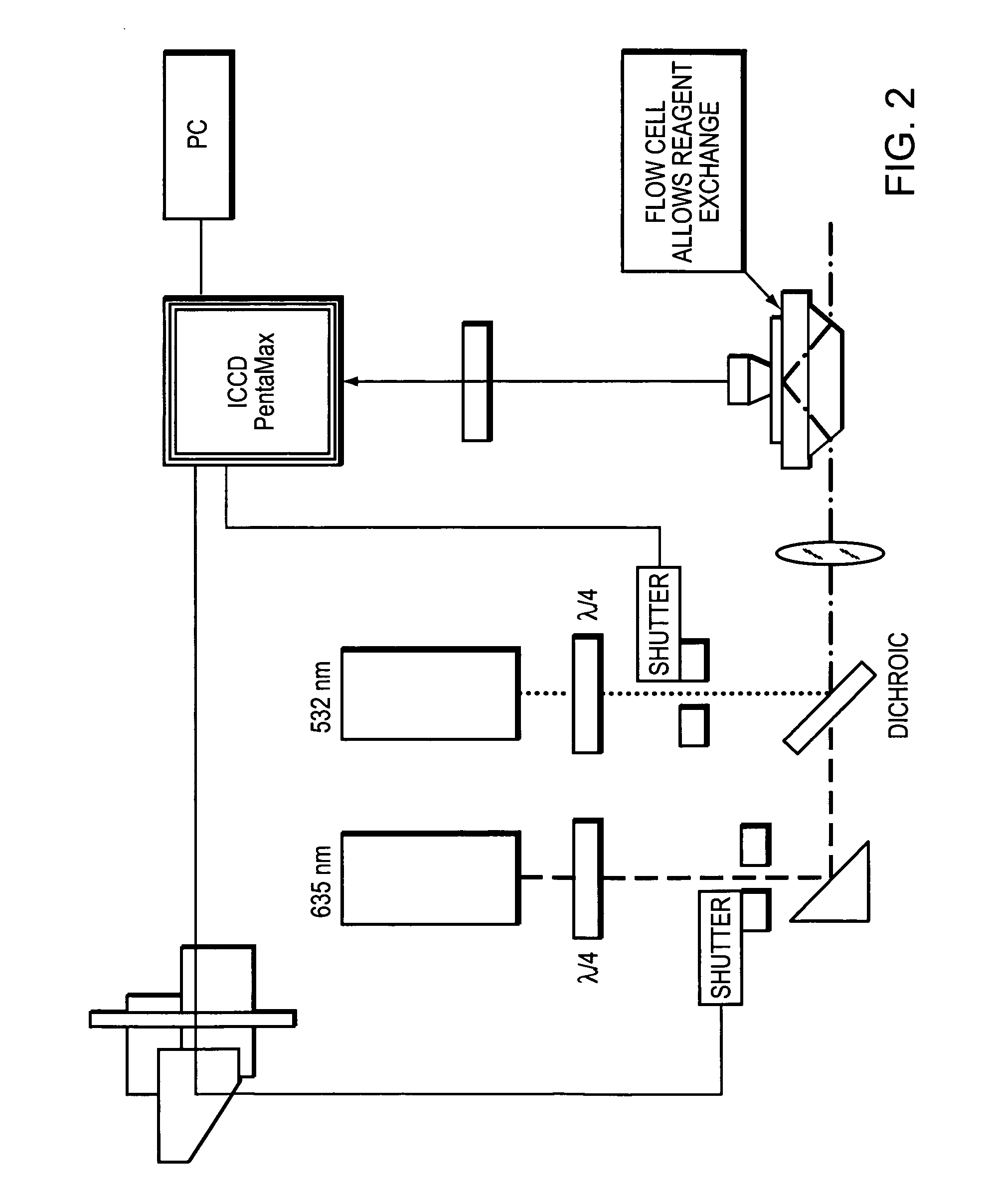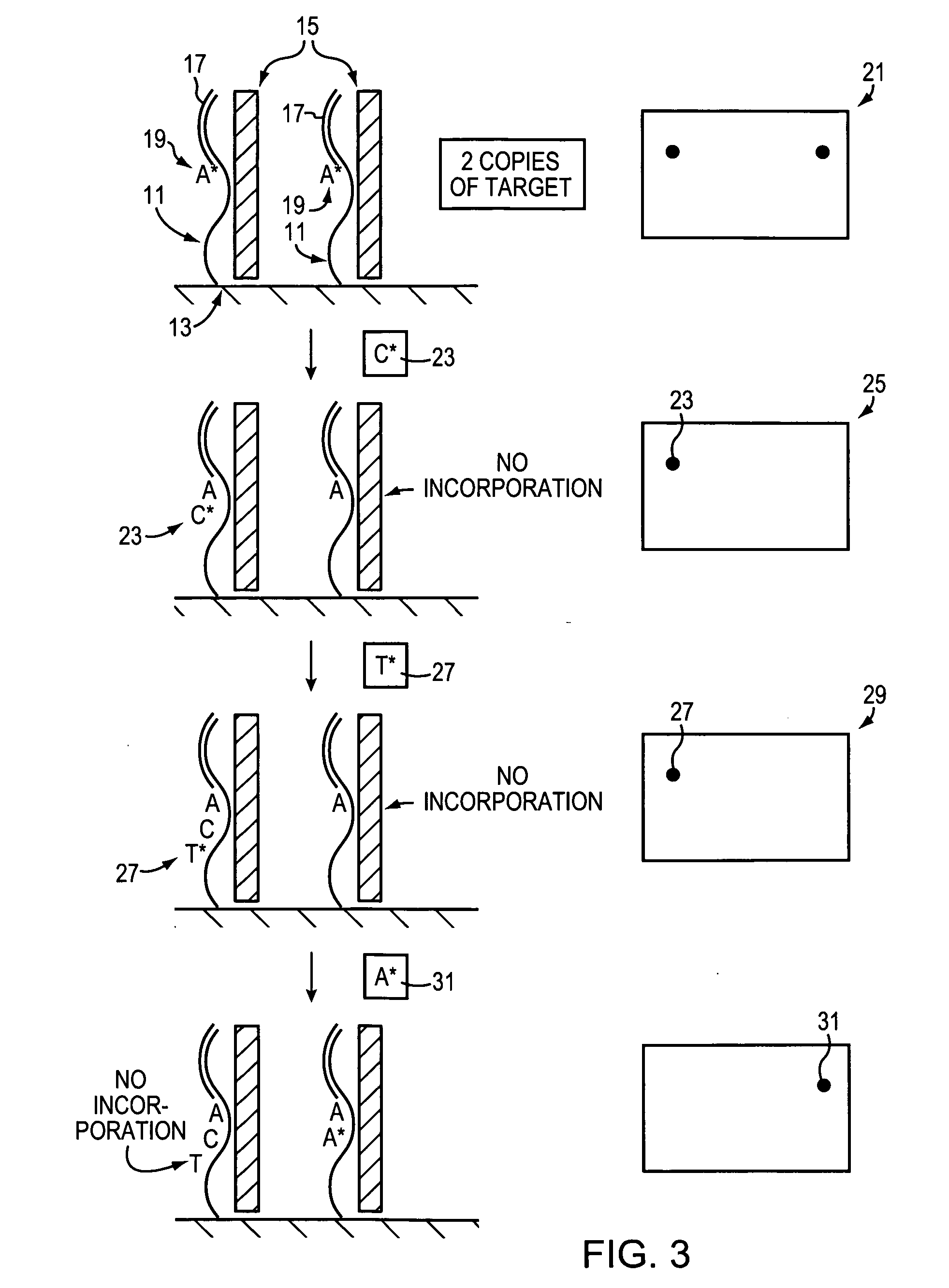Use of single-stranded nucleic acid binding proteins in sequencing
a single-stranded nucleic acid and sequencing technology, applied in the direction of microorganism testing/measurement, fermentation, biochemistry apparatus and processes, etc., can solve the problems of insurmountable obstacles in single-molecule sequencing, the application of sequencing-by-synthesis techniques to single-molecule sequencing has proved difficult, and the current sequencing-by-synthesis methods fail to consistently provide detectable and accurate signals, etc., to achieve stable nucleic acid sequencing reaction, improve speed, fidelity or processivity
- Summary
- Abstract
- Description
- Claims
- Application Information
AI Technical Summary
Benefits of technology
Problems solved by technology
Method used
Image
Examples
example 1
Stabilizing a Nucleic Acid Sequencing Reaction
[0045] In this method, a target nucleic acid sequence (template) of a single-stranded nucleic acid is exposed and stabilized with a single-stranded nucleic acid binding protein. The template and single-stranded nucleic acid binding protein also are exposed to a primer, a polymerase, and nucleotides (or nucleotide analogs). First, a target nucleic acid is obtained from a patient using any of a variety of known procedures for extracting the nucleic acid. Although unnecessary for single molecule sequencing, the extracted nucleic acid can be optionally purified and then amplified to a concentration convenient for genotyping or sequencing work. Nucleic acid amplification methods are known in the art, such as polymerase chain reaction. Other amplification methods known in the art that can be used include ligase chain reaction, for example.
[0046] A single-stranded nucleic acid binding protein is selected to bind to the single stranded nuclei...
example 2
Detecting Incorporation of a Nucleotide
[0051] A nucleic acid sequencing reaction is accomplished as in Example 1. In this instance, the primer includes a label. When hybridized to a nucleic acid molecule, the label facilitates locating the bound molecule through imaging. The primer can be labeled with a fluorescent labeling moiety (e.g., Cy3 or Cy5), or any other means used to label nucleotides. The detectable label used to label the primer can be different from the label used on the nucleotides or nucleotide analogs in the subsequent extension reactions. Suitable fluorescent labels include, but are not limited to, 4-acetamido-4′-isothiocyanatostilbene-2,2′disulfonic acid; acridine and derivatives: acridine, acridine isothiocyanate; 5-(2′-aminoethyl)aminonaphthalene-1-sulfonic acid (EDANS); 4-amino-N-[3-vinylsulfonyl)phenyl]naphthalimide-3,5 disulfonate; N-(4-anilino-1-naphthyl)maleimide; anthranilamide; BODIPY; Brilliant Yellow; coumarin and derivatives; coumarin, 7-amino-4-methy...
example 3
FRET Labeling Methods
[0057] Nucleotide donor / acceptor. This method is generally similar to Example 2, however the nucleotides comprise either a donor and acceptor label. In this method, a primer is bound to a detectable label such as Cy3. The primer is selected to bind to the template nucleic acid that is attached to a surface. The surface is then washed and the positions of the Cy3-primed templates are recorded and bleached. Next, a Cy3 labeled nucleic acid and polymerase are introduced under optimal nucleic acid sequencing condition and the surface is washed. An image of the surface is then detected for incorporation of labeled nucleic acid. If there is no incorporation, the procedure is repeated with another nucleotide until a Cy3 labeled base incorporation onto the primer is detected. Once a Cy3 labeled nucleotide is detected, the label remains unbleached and the extension reaction is carried out in the presence of a Cy5 labeled nucleotide. After washing, an incorporation of a...
PUM
| Property | Measurement | Unit |
|---|---|---|
| temperatures | aaaaa | aaaaa |
| Tm | aaaaa | aaaaa |
| temperature | aaaaa | aaaaa |
Abstract
Description
Claims
Application Information
 Login to View More
Login to View More - R&D
- Intellectual Property
- Life Sciences
- Materials
- Tech Scout
- Unparalleled Data Quality
- Higher Quality Content
- 60% Fewer Hallucinations
Browse by: Latest US Patents, China's latest patents, Technical Efficacy Thesaurus, Application Domain, Technology Topic, Popular Technical Reports.
© 2025 PatSnap. All rights reserved.Legal|Privacy policy|Modern Slavery Act Transparency Statement|Sitemap|About US| Contact US: help@patsnap.com



